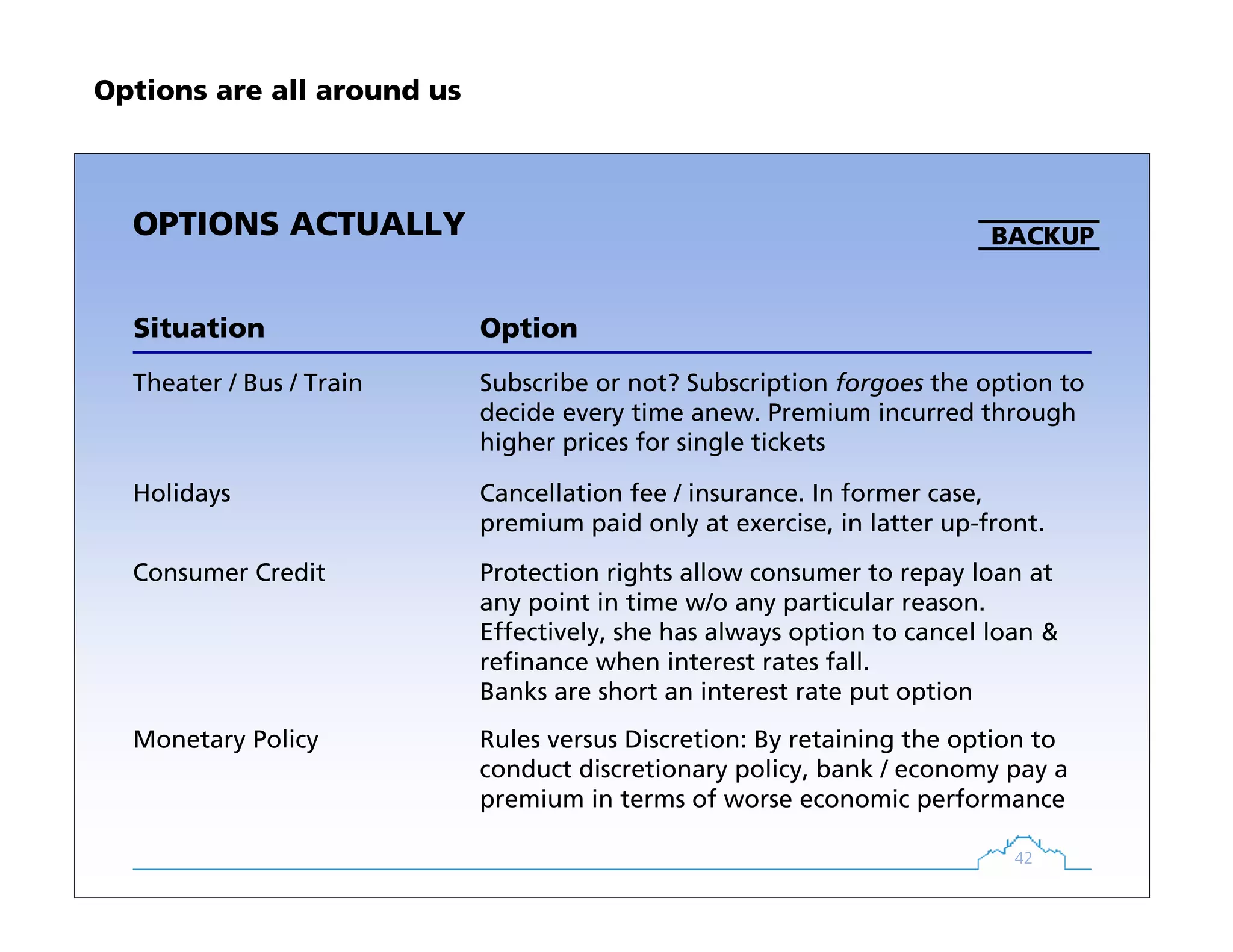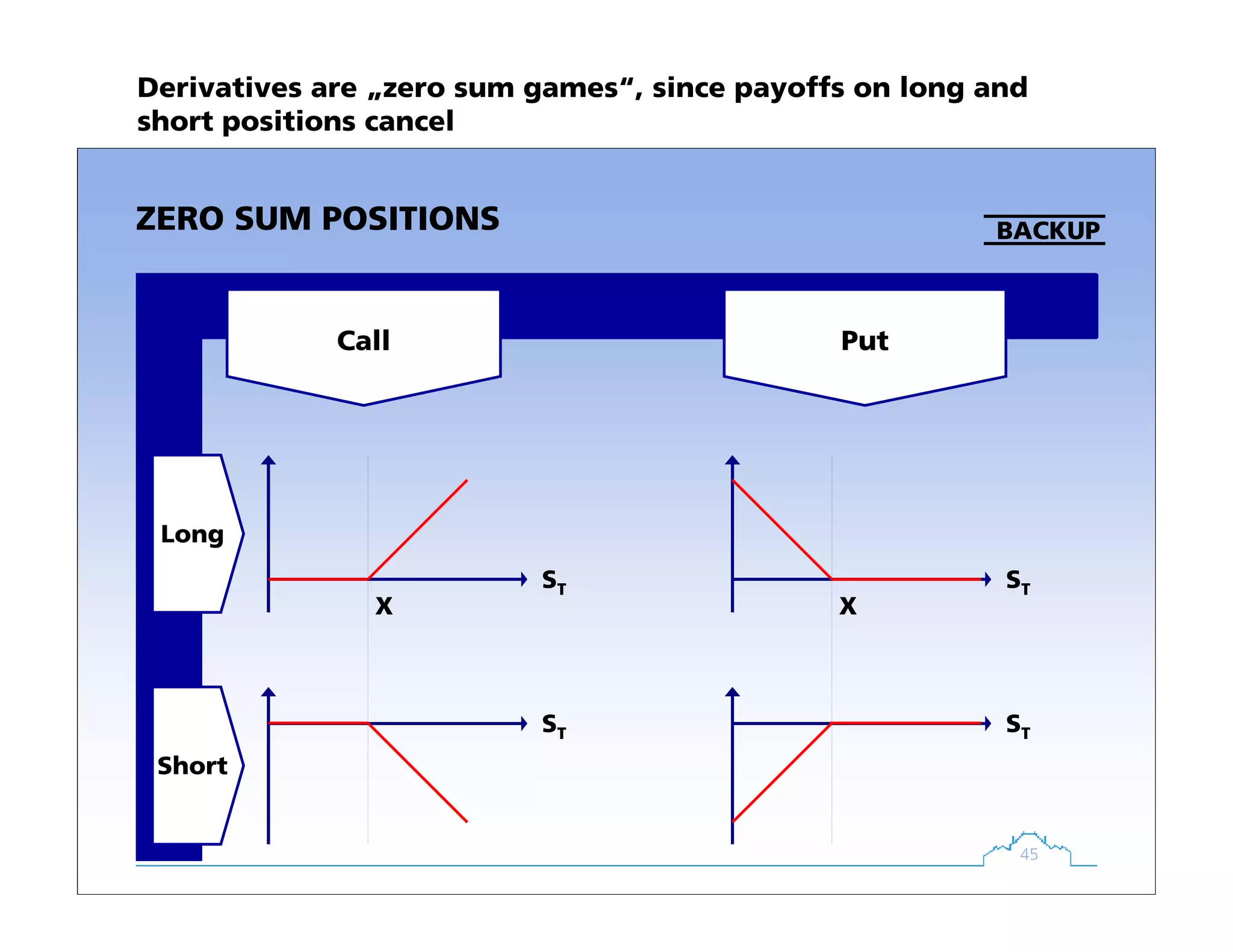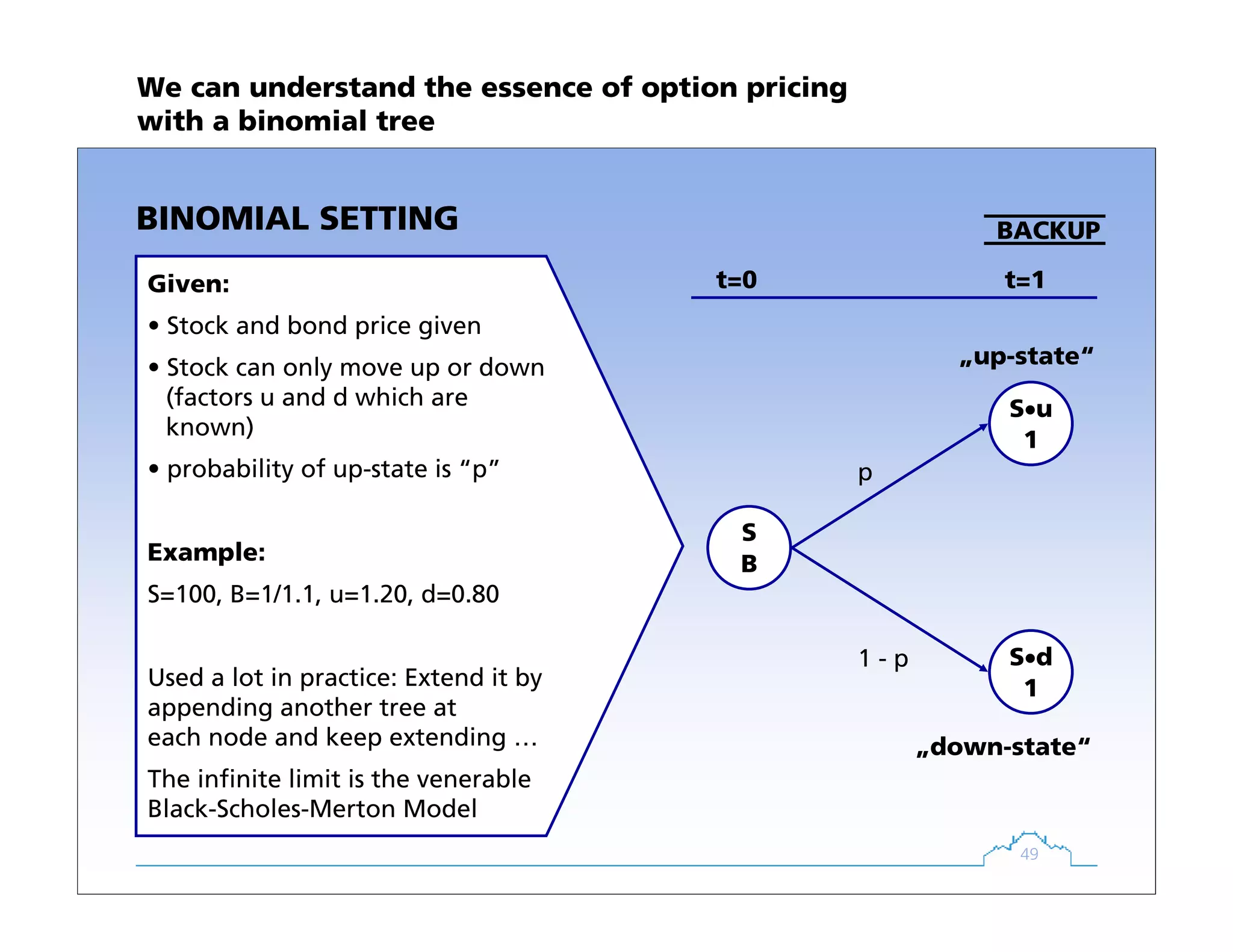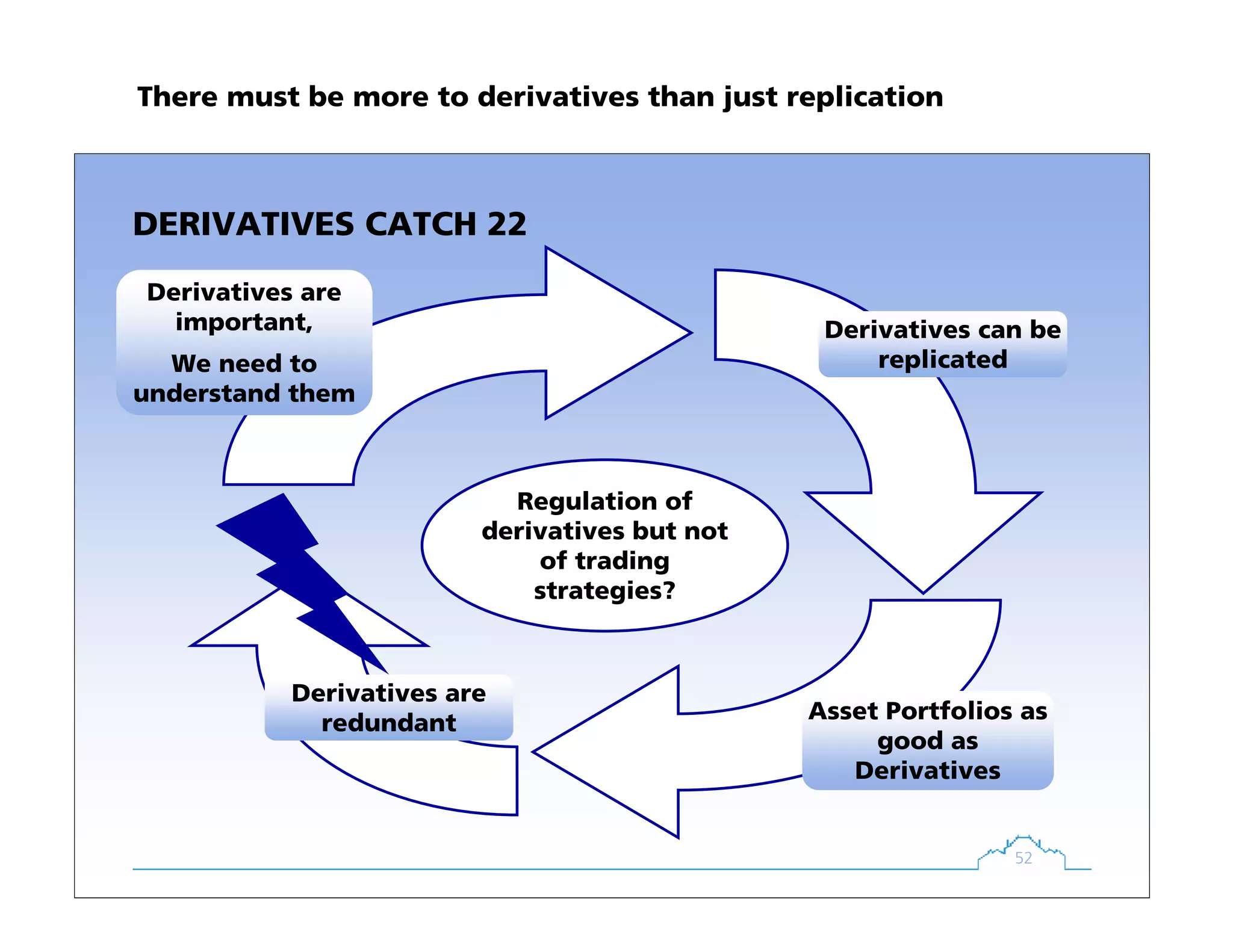The document discusses fixed income products and derivatives. It begins with an agenda covering key concepts like no-arbitrage pricing. It then examines various fixed income products, including zero coupon bonds, coupon bonds, forward rates, floating rate bonds, and interest rate swaps. It also discusses yield-to-maturity as the internal rate of return for a bond, assuming reinvestment at the same rate. Throughout, it emphasizes the principle of no-arbitrage pricing and how derivatives can be replicated and priced using a portfolio of basic assets.
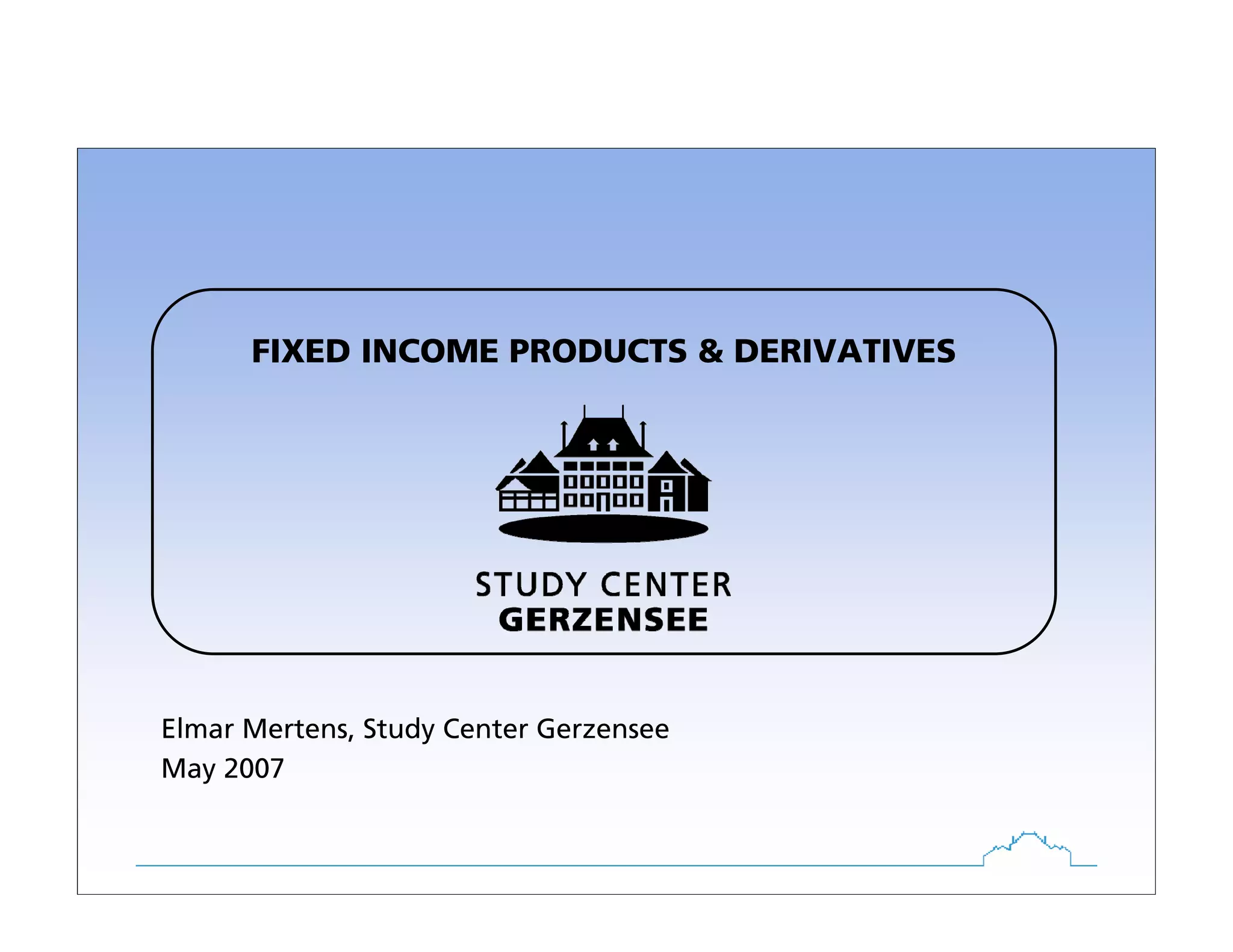

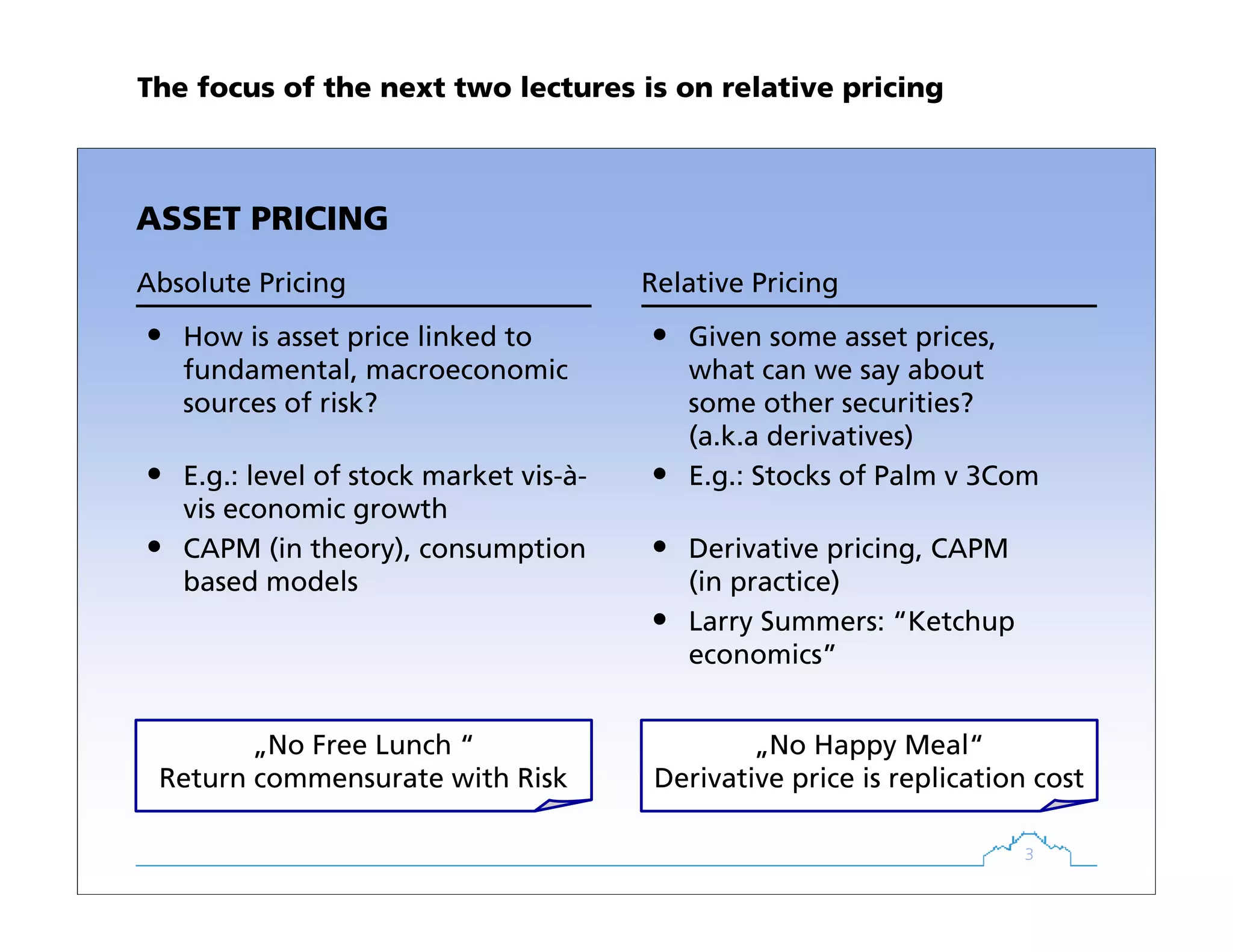






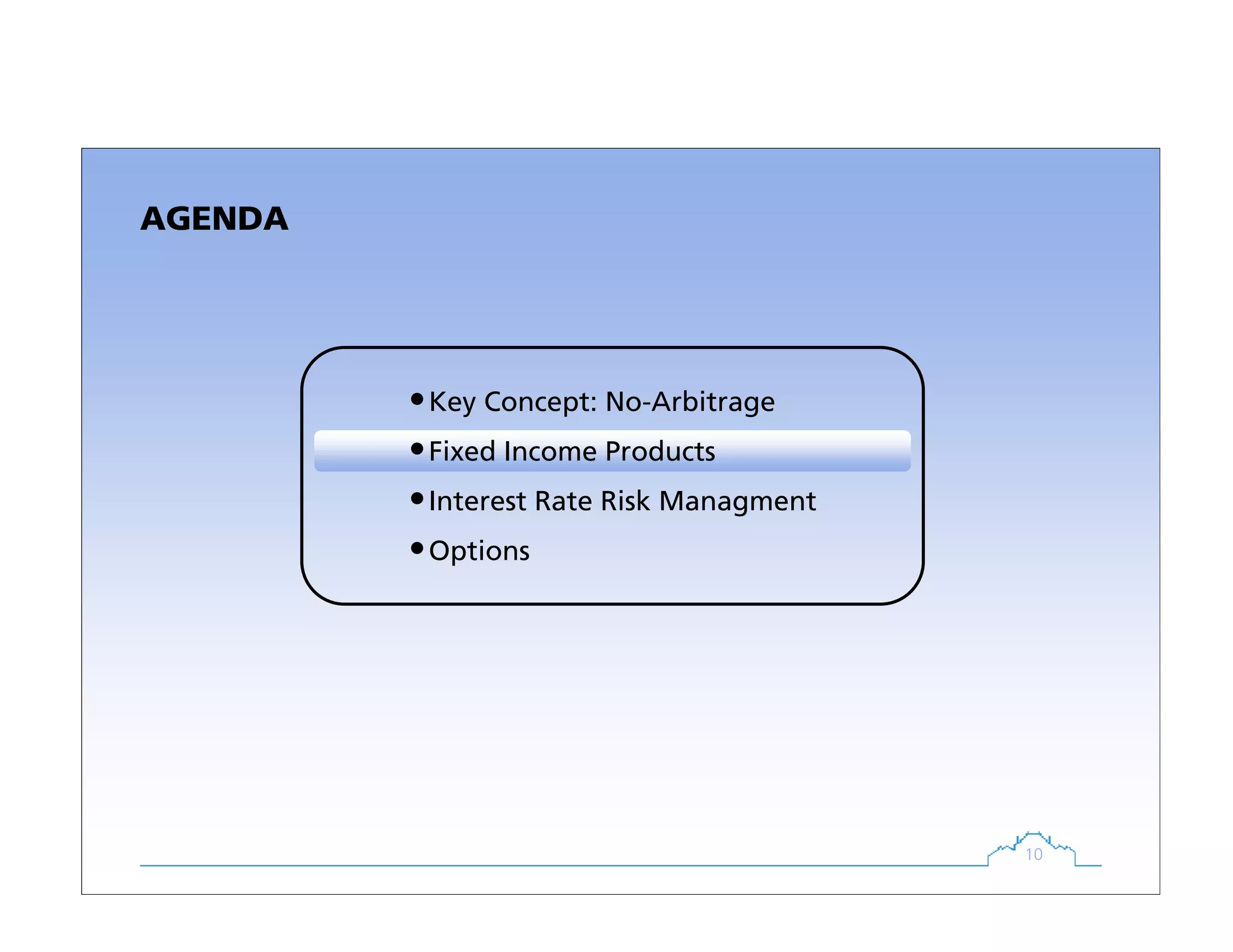
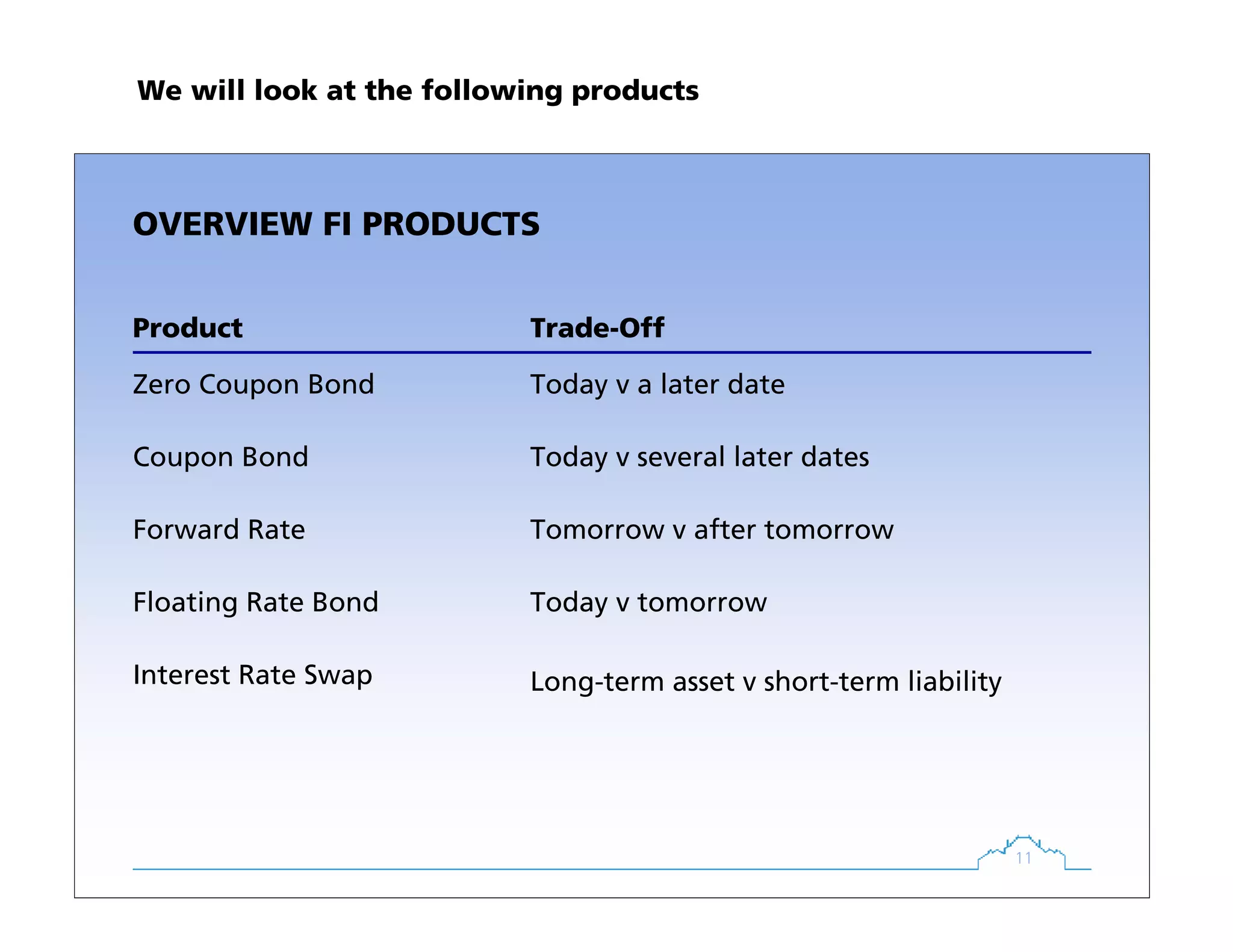


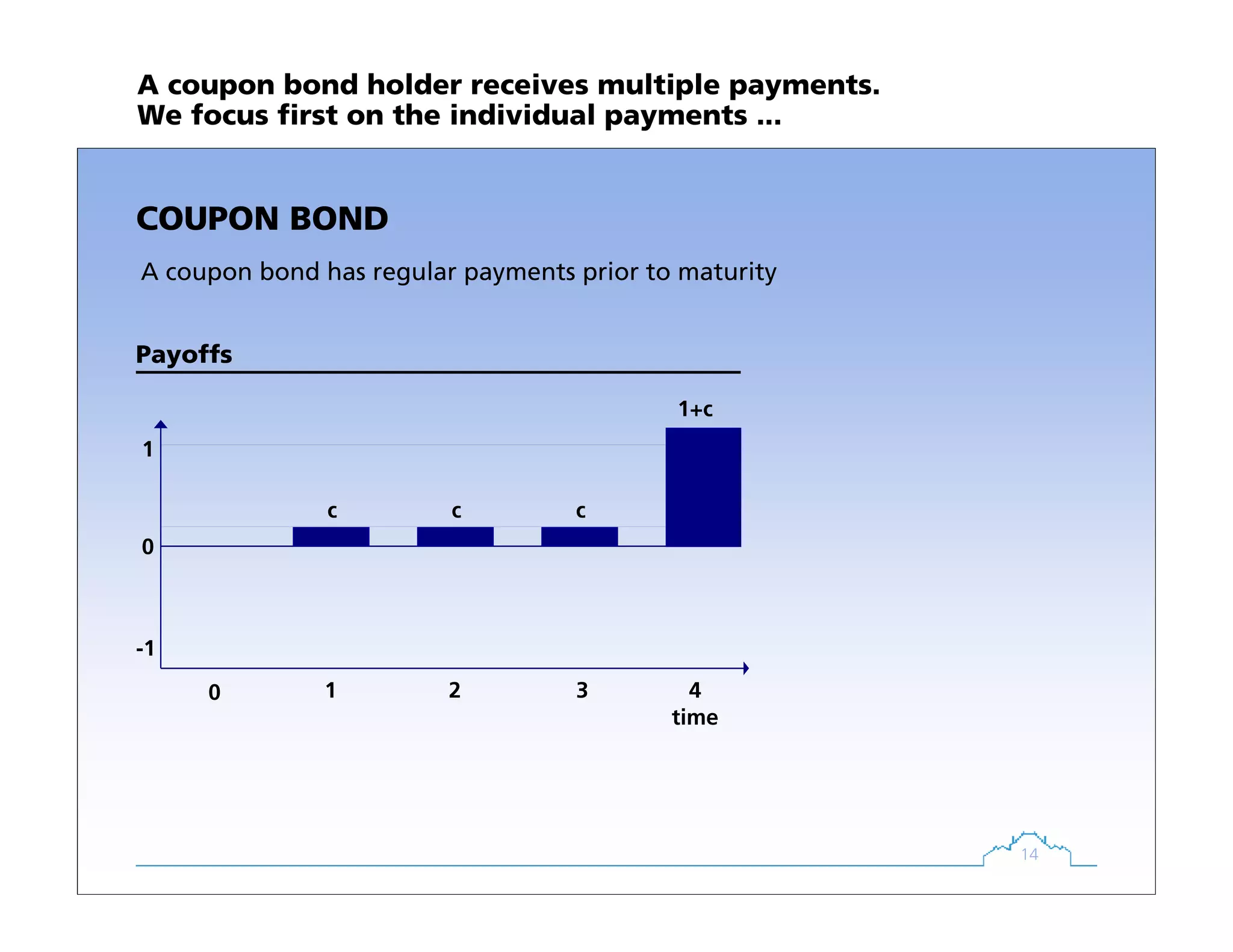
![15
ZERO BOND
A bond without coupons
Single payment at maturity: principal (here equal unity)
PricingPayoffs
TERMSHEET
1
(0, )
[1 (0, )]T
B T
i T
=
+
Example
Notes
Yield a.k.a. „spot rate“,
„zero rate“
-1
0
1
1 2 3 40
time
1
2
(0,1) 1.045 0.96
(0,2) 1.0475 0.91
(0,3) 0.87
(0,4) 0.82
B
B
B
B
−
−
= =
= =
=
=
Zero bonds are the basic building blocks of fixed income pricing](https://image.slidesharecdn.com/1725c8aa-d530-4a82-aa49-94434f60f969-160117130420/75/emNAFI2007-15-2048.jpg)
![16
PricingPayoffs
TERMSHEET
Examples
COUPON BOND
A coupon bond has regular payments prior to maturity
1(0, , )
[1 (0, )]
T
t t
c
B T c
i t
== ∑
+
1
[1 (0, )]T
i T
+
+
time
-1
0
1
c
1+c
1 2 3 40
cc
(0,4,10%) 2.3B =
(0,4,0.5%) 1.02B =
A coupon bond is just a collection of zero bond payments](https://image.slidesharecdn.com/1725c8aa-d530-4a82-aa49-94434f60f969-160117130420/75/emNAFI2007-16-2048.jpg)
![17
COUPON BOND AT PAR
1
1 [1 (0, )]
[1 (0, )]
T
tT
t
i T
c i
i t
−
−
=
− +
= =
+∑
For which coupon, would the
bond trade at par?
Par Value
(=1)
(1 ) [1 (0, )] T
c i T −
+ +
( 1)
[1 (0, 1)] T
c i T − −
+ −
M
1
[1 (0,1)]c i −
+
= Bond price
+
+
+
Par bonds have a coupon equal to their yield-to-maturity](https://image.slidesharecdn.com/1725c8aa-d530-4a82-aa49-94434f60f969-160117130420/75/emNAFI2007-17-2048.jpg)
![18
PricingPayoffs
TERMSHEET
(0, )B t =
Examples
FORWARD RATES
An agreement today, to borrow money between t and T at rate f(0,t,T)
[1 (0, )]
(0, , ) 1
[1 (0, )]
T
T t
t
T t
i T
f t T
i t
−
−
+
= −
+
1
4 2
2
1.051
(0,2,4)
1.0475
f
⎛ ⎞
= ⎜ ⎟
⎝ ⎠
8.06%=
[1+f(0,2,4)]2
-1
0
1
1 t=2 3 T=40
time
B(0,2)
B(0,2)
(0, ) [1 (0, , )]T t
B T f t T −
+
Replicate with
long/short position
in zeros
Forward Rates lock in future conditions for borrowing and lending](https://image.slidesharecdn.com/1725c8aa-d530-4a82-aa49-94434f60f969-160117130420/75/emNAFI2007-18-2048.jpg)
![19
NotesPayoffs
CARRY TRADE
Example of a simple, zero-investment portfolio.
Borrow short-term and lend long-term with different maturities
• No initial capital,
zero price
• Effectively a forward
contract
• Risk of reinvestment/
repricing at T1
• Profitable if
• Or, if future spot rate
below today’s forward
2
2 1 2(1, )[1 (0, )]T
B T T i T− +
1
1[1 (0, )]T
i T> +
2 1 1 2(1, ) (0, , )i T T f T T− <
-1
0
1
1 T1=2 3 T2=40
time
[1+i(0,2)]2
[1+i(0,4)]4
BACKUP
The carry trade bets on differences between future spot rates
and today’s forward rates](https://image.slidesharecdn.com/1725c8aa-d530-4a82-aa49-94434f60f969-160117130420/75/emNAFI2007-19-2048.jpg)
![20
ZEROS AND FORWARDS BACKUP
1
11 (0, ) [1 (0, 1, )]T T
ti T f t t=+ = + −∏
1 (0, , )f t t n+ + =
No-Arbitrage implies that zero
rates are geometric averages
of forward rates
Likewise, forward rates are
geometric averages of forward
rates
1
1
0[1 (0, , 1)]n n
j f t j t j−
= + + + +∏
The math is simple: (0, )B T =
(0,2) (0,3) (0, )
(0,1)
(0,1) (0,2) (0, 1)
B B B T
B
B B B T −
K
What do forward rates tell
us about market
expectations of future
spot rates?
Do they say more than
current spot rates?
Multi-period zeros are like a sequence of forward contracts](https://image.slidesharecdn.com/1725c8aa-d530-4a82-aa49-94434f60f969-160117130420/75/emNAFI2007-20-2048.jpg)

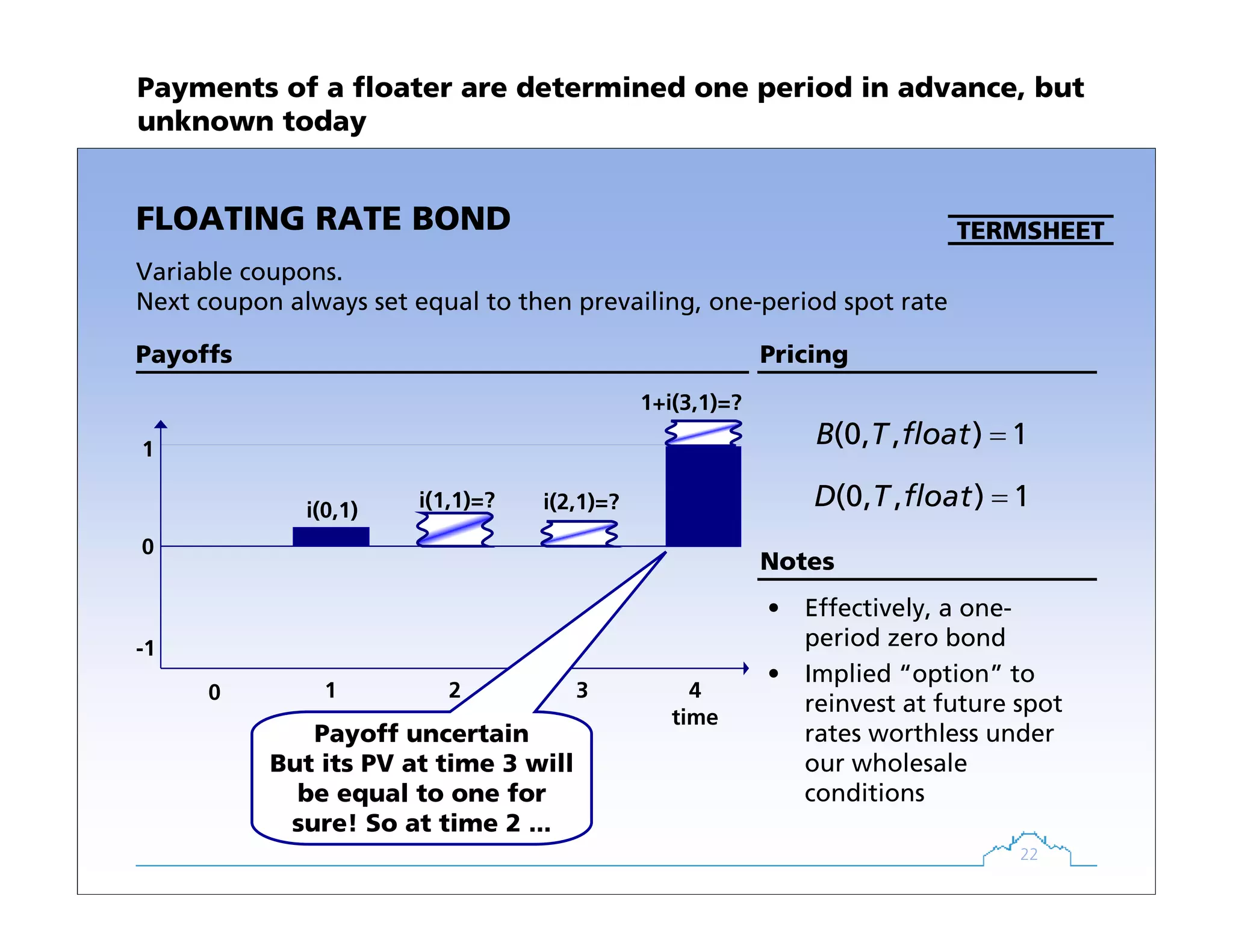
![23
PricingPayoffs
TERMSHEETINTEREST RATE SWAP
Exchange of interest rate payments: fixed v floating. No exchange of principal
Interest rates calculated for „notional“ principal
• A portfolio of coupon
bond (long) and floater
(short) with same
principal
• Here: “fixed receiver“,
opposite picture for
fixed payer
• Coupon such that initial
value is zero: Fixed-leg
is par bond!
1
1 [1 (0, )]
[1 (0, )]
T
tT
t
i T
c
i t
−
−
=
− +
=
+∑
Example
4y year swap-rate: 5.08%
time
-1
0
1
1 2 3 40
i(1,1)=? i(2,1)=?i(0,1) i(3,1)=?
ccc c
Swaps match a floater with a fixed coupon bond](https://image.slidesharecdn.com/1725c8aa-d530-4a82-aa49-94434f60f969-160117130420/75/emNAFI2007-23-2048.jpg)
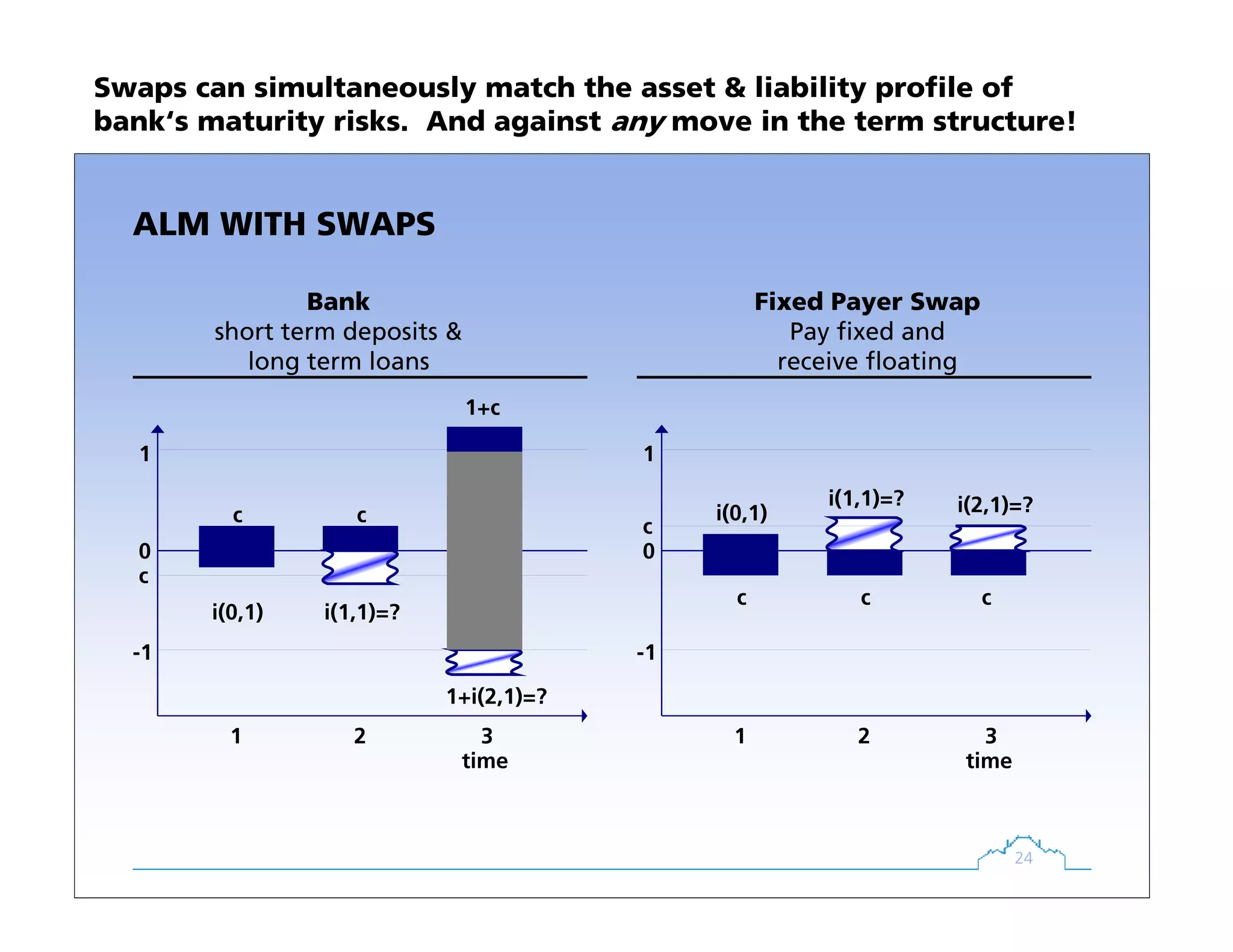




![29
DURATION
Present
Values
time
What is the
average time
until all claims
are paid?
(... and let us
average with
present-value
weights)
1
(1 ) (1 )
(0, , )
(0, , ) (0, , )
t T
T
t
c i i
D T c t T
B T c B T c
− −
=
+ +
= +∑
1
[1 (0, )] [1 (0, )]
(0, , )
(0, , ) (0, , )
t T
T
teff
c i t i T
D T c t T
B T c B T c
− −
=
+ +
= +∑
To understand price sensitivity, duration is important.
It measures the center of gravity of the payoffs‘ present values](https://image.slidesharecdn.com/1725c8aa-d530-4a82-aa49-94434f60f969-160117130420/75/emNAFI2007-29-2048.jpg)












